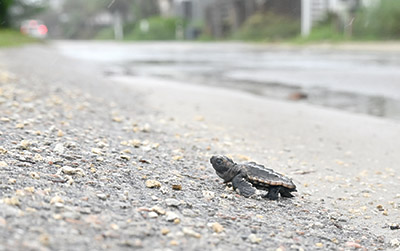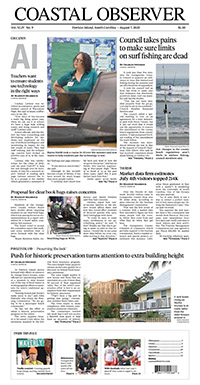Environment
Lights lead sea turtle hatchlings to their death

Fueled by the yolk from its egg and millions of years of instinct, a loggerhead sea turtle hatchling scrambled across the wet pavement on Springs Avenue.
It should have been heading toward the ocean. Instead, it climbed a gravel parking space on the edge of Pawleys Creek. Blocked by landscape timbers, it turned back to the road, skirted a stormwater drain and swam briefly through the water pooled on the side of the road.
“There’s a name for it. DNR calls it disorientation,” said Rick Scott, referring to the state Department of Natural Resources.
He heads the sea turtle monitoring group SCUTE, which operates with permits from the agency.
The cause was outdoor lighting. The result was evident on Springs Avenue last week.
After the hatchling emerged from the stormwater, the wind from Tropical Storm Debby caught it and flipped it on its back. The turtle righted itself and kept crawling.
The turtle was lucky. Ten other hatchlings from a nest that contained 142 eggs lay dead on the road.
Before the same fate befell the last hatchling, Scott arrived, put on rubber gloves and placed the turtle in a bucket. He also collected the remains of its nest mates.
Scott cut between the beach houses, looking for any sign of other strays. He placed the hatchling at the edge of the tempest tossed surf. He buried the dead in the sand near their nest, one of a cluster of three laid in the dune in front of one house.
Two of the dead hatchlings were in the road more than 600 feet from the nest.
“We should be outraged about that,” Scott said.
He found a group of people staying at a rental house who told him they found nine live hatchlings under the house at 1:30 a.m. They scooped them up in paper cups and put the turtles in the ocean.
There were lights under the house, they told Scott. They said they couldn’t figure out how to turn them off.
“The good news is his kids picked them up at 1:30 in the morning and put them back in the water,” Scott said. “The bad news is they couldn’t turn off the lights.”
The lights at the house were only part of the problem.
“There’s a glow from Myrtle Beach,” said Mary Schneider, who leads the SCUTE volunteers on Pawleys Island.
The hatchlings are naturally attracted to the light reflected off the ocean. There are local ordinances in place that require owners to prevent lights from shining on the beachfront during sea turtle nesting season. Those laws don’t cover the glow from lights away from the beach.
Schneider said volunteers have seen tracks heading north from newly-hatched nests. She believes that’s what happened with the strays last week. When they got to the nearby beach house, they turned inland toward the brighter light.
“We had the same thing last year,” Schneider said. “The houses are so close to the road and they don’t have the dunes to block the light.”
The hatchlings don’t all emerge at the same time, so it is impossible to know how long the surviving stray had been out of the next. It was moving at a brisk pace even though it had crawled a long way.
“The problem is they use up all that energy they need to get to the Sargasso Sea,” Schneider said.
The seaweed that gives the region its name provides food and shelter for the young turtles.
In addition to the hatchlings that died on the road, there was another hatchling that died in the nest, SCUTE volunteers found during a nest inventory at dawn three days later. There were also 19 undeveloped eggs.
One more hatchling was still in the nest. Schneider pointed to its “egg tooth” as evidence that it had just emerged from its shell.
“The ones still in the nest aren’t the strongest,” said Sue Tanner, a SCUTE volunteer.
It was placed in a bucket with some sand and ocean water. It began to move around and was set down on the beach, where the waves had diminished following the storm.
The hatchling tried to crawl, but its rear flippers had not yet fully extended. It went back in the bucket until it had time to stretch out.
Schneider said she would release it later that day and was certain it would find its way straight to the ocean.




